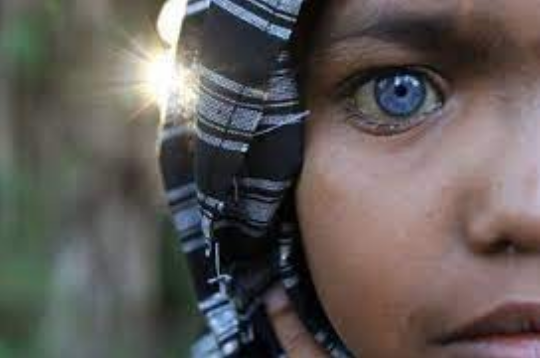Indonesia’s Blue-Eyed Kaimbulawa Tribe
 Jojon. (2020). A child of the Buton tribe in Kendari, Southeast Sulawesi. In Antara Foto.
Jojon. (2020). A child of the Buton tribe in Kendari, Southeast Sulawesi. In Antara Foto.
Among the countless, diverse indigenous tribes that Indonesia has been gifted with, the Kaimbulawa tribe would be an incredibly unique and underappreciated tribe to be discussed in this month’s World Indigenous Day. The Kaimbulawa tribe comes from Indonesia’s 19th largest island, the Buton island, located in the Southeast Sulawesi region of Indonesia. Although the Kaimbulawa tribe is home to only 1,010 individuals from the 450,000 people on Buton island, their distinct genetic characteristics make them garner an amount of international attention as well as become a unique part of Indonesia’s face and diversity. The Kaimbulawa tribe are mostly born with bright blue eyes, differing from the common Indonesians who are often born with dark-colored eyes. Such traits are mostly found in Caucasians.
Two factors contribute to such a phenomenon. Firstly, a genetic syndrome called the Waardenburg syndrome occurs in 1 out of 42,000 people in the world. Hearing loss and special pigmentation of the eye also occur in people with the syndrome. Such biological uniqueness was studied to have been passed down from generation to generation, which would logically and factually lead to the second factor which is ancestry from old Kaimbulawa to Portuguese seafarers. Their history could be traced back to the 16th century when Portuguese traders and explorers arrived on the island of Sulawesi, creating a pitstop in Buton island, driven by their interest in Indonesia’s archipelago and their search for spices such as nutmeg and cloves. There, those Portuguese seafarers established trade relations, and some of them got married to Kaimbulawa locals. The reigning king of the area at the time, King Siompu II, even married his daughter, Wa Ode, to a Portuguese sailor called Pitter. This resulted in the fusion of the original Kaimbulawa traits with European traits.
Surprisingly, the interconnection then gathered animosities from the Dutch during the colonization era, viewing the Kaimbulawa-Portuguese people as traitors, which affected their social standing. Negative perceptions also happened in the later era, where kids with such a trait received bullying and acts of discrimination in schools, making them feel inferior and have low self-esteem. This actually led them to flee from social interactions and outside associations. However, the stigma against the blue-eyed Kaimbulawa has started to disappear due to social media. Through tale and image sharing, Indonesian internet users have become more curious and interested in their history. As time went on, they also came to appreciate their ancestry. They are increasingly welcomed to gatherings and events.
The Kaimbulawa tribe also has precious culture, values, and traditions. Islamic traditions and customs are deep in their soul, where they actively preserve and uphold Islamic traditions, values, and customs in their daily lives. With that, it is not odd that Islamic practices are always in their lives, with kindness, helpfulness, and affection towards others constantly being practiced. They value communal living and maintain dignity in their interactions. Family is also a big part of the tribe’s heart, where familial customs and rituals such as Cumpe and Sampua that symbolize solidarity, unity, and strengthening social bonds among the community are integral and always properly done. Traditional clothing, such as Buton Alana Bulua and tenun sarong, holds special significance as a form of identity and is worn during various events and ceremonies. The preservation of Kaimbulawa and Butonese culture is a collective effort by both the government and the community. Traditional tenun sarongs, once used as currency, are now celebrated as valuable cultural symbols.
The Kaimbulawa tribe is such a unique and underappreciated Indonesian indigenous group. The history of European seafarers who explored and mingled with the locals of Buton Island resulted in the current blue-eyed Kaimbulawa tribe people. In the past, the people of the Kaimbulawa tribe faced much judgment and stigma. Nowadays, social media helps reduce this stigma by presenting the people of Kaimbulawa through a different lens. There is much more of the tribe that should be appreciated, such as their high appreciation and value towards the soul of families, morals, and Islamic traditions, all deeply ingrained in their daily lives. Fostering communal living and respect towards each other has always been spearheaded. They also do not forget to represent their identity fascinatingly through traditional clothes such as Buton Alana Bulua and tenun sarong. The Kaimbulawa tribe’s unique genetic characteristics, coupled with their rich cultural values and traditions, contribute to Indonesia’s diverse and fascinating culture.
REFERENCES:
Wisma Bahasa. (2020, October 13). Getting to know the Buton tribe, Indonesian natives with blue eyes. Wisma Bahasa. https://www.wisma-bahasa.com/getting-to-know-the-buton-tribe-indonesian-natives-with-blue-eyes/
Oktavia, M. H. (2021, March 6). The age old history behind sulawesi’s blue eyed villagers halaman all. Kompas.com. https://go.kompas.com/read/2021/03/07/003953074/the-age-old-history-behind-sulawesis-blue-eyed-villagers?page=all
Davies, J. (2020, October 1). Indonesian tribe with extremely rare electric blue eyes photographed. Mail Online. https://www.dailymail.co.uk/news/article-8794311/Indonesian-tribe-extremely-rare-electric-blue-eyes-genetic-fluke-photographed.html
Ruiz, M. (2022, August 24). This Indonesian tribe has the bluest eyes ever seen. Travel Tomorrow. https://traveltomorrow.com/this-indonesian-tribe-has-the-bluest-eyes-ever-seen/
Fadia, F. (2022, July 20). Mengenal keanekaragaman suku Buton. Depok Pos. https://www.depokpos.com/2022/07/mengenal-keaneoaragaman-suku-buton/

